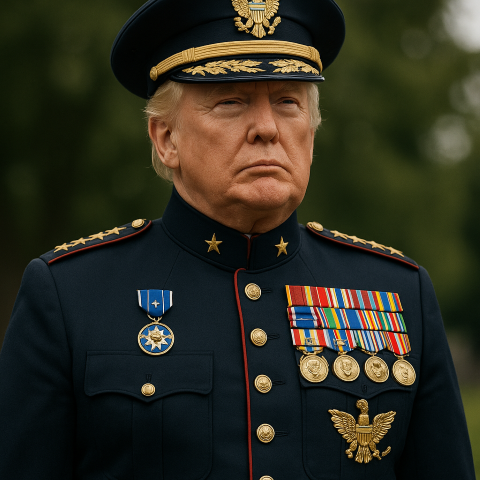The Parade
Title: The General of None
On June 14, 2025, Washington, D.C. was louder than usual.
The skies above the National Mall shook as a squadron of Apache helicopters flew overhead in formation. Tanks—real tanks—rumbled down Constitution Avenue, their massive frames softened only slightly by rubber track pads to protect the streets. Spectators lined both sides, waving flags, filming with phones, or standing still, uncertain whether to cheer or grimace. On this day, the parade was officially in celebration of the 250th anniversary of the U.S. Army.
Unofficially, it was also Donald J. Trump’s 79th birthday.

Seated high on a custom-built dais near the Lincoln Memorial, Trump watched it all unfold. He wore a dark navy uniform styled loosely on a five-star general’s attire, stitched with medals that shimmered in the morning sun. None were earned in military service—he had never served—but each carried some symbolic weight: “Medal of National Prosperity,” “Order of the Southern Border,” “Medal of Twitter Valor.” Some were crafted solely for the day.
Flanked by allies—Steve Bannon on one side, Kimberly Guilfoyle on the other—Trump stood when the tanks passed. Behind him, the bleachers held former administration officials, conservative media personalities, and a few sympathetic foreign dignitaries. They applauded as F-22s performed a flyover, spelling out “USA” in smoke.
Across the Reflecting Pool, behind a row of temporary fencing and two layers of National Guard, a different crowd had gathered. Protesters.
They held signs: “Valor isn’t cosplay.” “Stop stealing our uniforms.” “No tanks on democracy’s streets.”
Some wore mock versions of Trump’s uniform, complete with toy medals and plastic epaulettes. A group of veterans stood silently, backs turned to the parade, hands folded over old photos of friends who never returned from war.
“He can play dress-up all he wants,” one veteran muttered to a reporter, “but real generals don’t need to throw themselves a parade.”
Back on the grandstand, Trump lifted his hand in a wave—not to the troops, but to the cameras. His voice boomed from speakers when he began to speak, the crowd falling quiet out of curiosity if not respect.
“I stand here today,” he declared, “not as a former president, but as a symbol of strength, of greatness, of everything this country once was and can be again. These medals? They’re from you, the people. For what we’ve done, for what we’re about to do.”
Applause erupted from his side of the Mall. Boos echoed from the other.
The parade resumed. A float rolled by, bearing a golden eagle and the words Faith, Flag, Family. Children in matching red-white-and-blue outfits performed a cheer routine beside it. Trump beamed.
At one point, a balloon in the shape of a mushroom cloud—released by protesters—drifted across the sky. Security scrambled. Trump didn’t seem to notice.
He was too busy watching the parade of tanks and pageantry and carefully choreographed adoration, surrounded by people who told him what he wanted to hear, wearing the uniform of a general he never was.
It was, by design, a spectacle of contradictions: genuine patriotism alongside performance; reverence next to resentment; cheers overlaid with chants. The camera angles on conservative networks would show the proud machinery, the roaring jets, and the “beloved leader” watching solemnly.
The overhead drone shots, unfiltered, told a messier truth: two Americas, staring at each other across a reflecting pool, each convinced the other had forgotten what real honor looks like.
